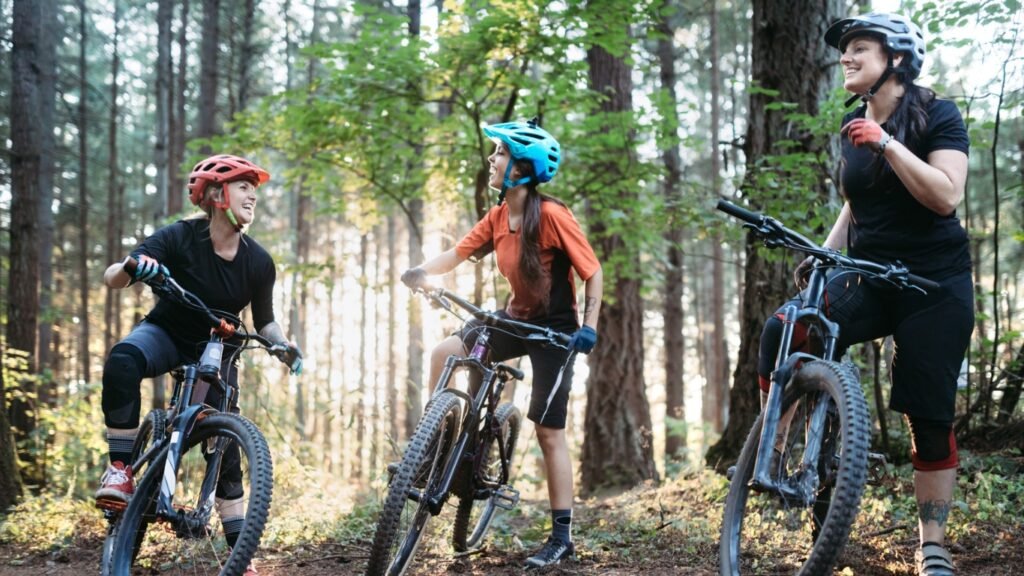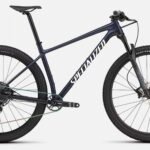Choosing the first mountain bike is one of the most confusing parts, especially when you are a beginner.
That’s why, in this article, I am going to discuss some of the most important factors that you have to look up to when choosing your first mountain bike.
In this mountain bike buying guide, we will talk about material, size, comfortability, and many more things that will help you choose a mountain bike that fits you and meet your requirements.
How to Buy Your First Mountain Bike

Here are seven common things to consider that will help you choose the right mountain bike for the first time.
1. What Type of Mountain Bike Should a Beginner Get?
There are many types of mountain bikes that you can choose from (at least 10).
For example, if you want to ride on loose terrains, you can get a fat bike that comes with thick and heavy tires. And if you want to ride on downhill trails, then you can look for an enduro or downhill bike.
If you want for multiple uses, you can look for trail or cross-country bikes. Now let’s talk about them one by one.
Cross-Country Bikes (XC):
Cross Country Bikes are faster and specifically designed for smooth trails.
They are lightweight and low maintenance. Their suspension travel is usually around 80 mm to 100 mm.
If you want to ride your bike on smooth trails and less on technical trails, then you can go on cross-country bikes.
However, you will have to do a lot of pedaling work to ride your bike.
Trail Bikes:
The Trail bike is one of the best mountain bikes you will ever find.
It is versatile, so you can use it on various trails like climbing, technical sections, downhill sections, muddy, rocky, on-road, off-road, or anywhere else.
Trails bikes usually come with 120 to 150 mm suspension travel. And that’s why they are a good choice for any rider, be it a beginner, intermediate or an advanced but they’re expensive.
Enduro Bikes:
If you are a serious rider or want to become one, then you can choose to go with enduro bikes.
They are built for more aggressive riding. They come with a suspension travel of 160mm to 180mm.
Enduro bikes are excellent for technical descent and rough terrain. But they are a little advanced bikes for a beginner who is just starting mountain riding for the first time.
Downhill Bikes:
This is another advanced type of mountain bike that comes with full suspension travel, up to 180 mm plus.
They are good for steep, gnarly, rocky trails, and they can also perform better on high-speed descent as they are designed for that.
However, downhill bikes are not ideal for the first-time buyer who is just starting a mountain biking journey and is young right now.
If you are a beginner, then I recommend you go with a trail bike as they are versatile and can be used everywhere, including downhill trails and regular roads, etc.
When you get more experience, you can upgrade your bike to downhill bikes or enduro bikes.
But, even being a beginner, if you want to start your journey with downhill trails, then it’s okay to go with downhill bikes. As it’s your main focus.
Also read: Full-Suspension vs. Hardtail: Which Mountain Bike is the Best?
2. How to Choose the Right Mountain Bike Size

When choosing your first mountain bike, you first have to look at the bike’s frame size and choose the one that suits your height.
You can use the bike size either in inches for traditional frames, or the shop owner will give you a chart, like small, medium, and large for modern bikes.
When you go to the mountain bike shop and choose a bike, you first want to stand with your legs about 6 inches apart from the bike and then measure the distance from your crotch to the floor to determine the best frame sizes.
For example, if your inseam size is around 30 inches, then you will look for a bike size around 15 to 17 inches or medium size.
Top Tube Length:
Many people do not discuss the bike’s tube size, which is important.
But why?
Actually, the top tube determines the overall length of the bike and influences your reach to the handlebars.
If the top tube is too long, you’ll feel stretched out, and you may find it difficult to control the bike. If it’s too short, you’ll feel cramped.
That’s why you should get the right top tube length; it’ll make a big difference in comfort, especially on longer rides.
Standover Height:
This is the height of the top tube. So, you want enough clearance to stand flat-footed while still having some space between you and the tube.
Space needs to be at least 1-2 inches between your crotch and the top tube.
This is important for safety and comfort, especially when you need to quickly hop off your bike.
Seat Height:
Adjusting the seat height is also another important factor in how well your bike fits.
When you sit on the bike, your legs should have a slight bend at the bottom of the pedal stroke (about 25-30 degrees).
This ensures you’re using your legs effectively and riding comfortably for longer periods.
A practical tip: When you’re buying a bike, don’t just look at the size charts.
Test ride the bike! It’s the best way to figure out if a bike fits you. Besides this, adjust the saddle and handlebars as needed and make sure they feel comfortable.
Also read:
- How to Choose the Right Mountain Bike Helmet
- How to fix flat tire of your Mountain bike (step by step)
3. Mountain Bike Suspension: Hardtail vs. Full Suspension
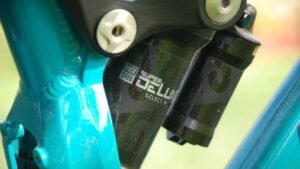
Bike suspension is important for a comfortable ride.
If you buy a mountain bike with full suspension, then you’ll feel the most comfortable compared to a non-suspension bike.
The extra comfort and control made all the difference.
Hardtail bikes have only front suspension, which makes them ideal for smoother trails or for beginners who prefer simplicity without the added weight of rear suspension.
Besides this, hardtail tends to be more budget-friendly and requires less maintenance.
So, if you plan to stick to smoother trails or light cross-country riding, a hardtail is a good mountain bike for you.
Full Suspension Bikes:
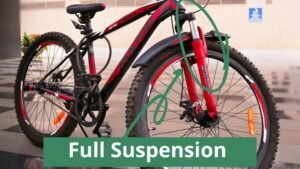
These bikes have both front and rear suspension, which can absorb bumps and will provide you with better control on rough terrain.
However, they are expensive and heavy compared to hardtail bikes. If you want to tackle technical or downhill trails, then full-suspension bikes are definitely worth considering.
You just want to remember one thing that you’ll have to maintain regularly.
Practical Tip: If you’re a beginner, then hardtail bikes are the best option for you. Because they’re simple, lighter, and affordable, besides this, they’ll still perform great on most trails.
4. Components: Gearing, Brakes, and Tires
Gearing:
I don’t want to confuse you by discussing too much about gearing systems.
However, as you’re a beginner and choosing your first mountain bike, it’s suggested that you go with the single front chainring.
It’s very simple, requires less maintenance, plus it’s enough for most mountain biking needs.
Many beginners make the mistake of choosing a 2x setup when they start. After that, they constantly get confused about shifting and maintenance.
So, as a beginner mountain bike rider, keep it simple, but if you’re mature enough, then it’s okay to have a geared bike.
Brakes:
Disc brakes are essential for mountain biking. Whether they’re hydraulic or mechanical, they’ll give you better stopping power, especially in muddy or wet conditions.
Tires:
Tire thickness plays an important role in your riding experience. So, I recommend tires in the 2.2 to 2.4-inch range to beginners.
Most pro riders consider this width to be good, as it provides both balance and comfort.
Plus, it doesn’t make a bike heavy, too, which is good for beginners.
The tread pattern is also important—knobby tires provide better grip on dirt, but if you’re riding mostly on hard-packed trails, you might want something with a smoother tread.
Practical Tip: Don’t stress too much about components when buying your first bike.
I just want you to first focus on your own comfort and fit. In the future, as you gain more experience after that, you can upgrade components as needed.
Also read: Essential gear that every mountain biker should have
5. Budget: How Much Should You Spend on Your First Mountain Bike?
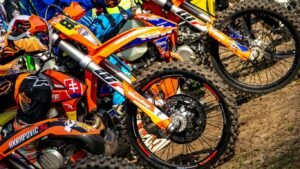
Many beginners think that spending more money means getting a better bike. They run after big names (Brands) rather than focusing on comfort and quality.
However, you don’t need fancy features on your first bike.
So, I suggest you do not spend too much (Especially when you’re a beginner and growing up, and mountain biking is just a simple hobby for you).
But, If you are serious about learning mountain biking and want to be a pro rider, and money isn’t the problem, then it’s okay to get an expensive one with more features.
However, You can also join our 4-week training program for beginner mountain bikers that will help you build mountain biking skills and endurance for a better riding experience.
Entry-Level Bikes ($400 – $800):
Great for beginners who are just getting into mountain biking.
These bikes will get you through most trails with good performance but don’t include high-end features.
If you’re just starting out, there’s no need to break the bank.
These bikes are reliable and straightforward and will perform well on smoother trails, light singletrack, and forest paths.
You’ll get basic suspension (usually a front fork), solid gearing systems, and durable tires. Don’t expect premium components, but for a beginner, they’re more than enough.
Practical Tip: Stick to this range if you’re just getting started. It’s affordable, and you’ll learn what you like or dislike about a bike, which helps you make a more informed decision when it’s time to upgrade later.
Mid-Range Bikes ($800 – $1,500):
These bikes offer a great balance between performance and price.
At this price point, you’re getting more durable components, better suspension, and lighter frames.
If you plan to ride regularly or on more technical trails, a mid-range bike can give you a better experience without going overboard.
Besides this, you’ll likely get a better set of wheels, a better suspension system (with more adjustability), and a drivetrain that’s more reliable for tackling steeper climbs and rougher descents.
The frame material may shift from basic aluminum to something a bit lighter or more responsive, like carbon fiber (although it’ll be at the high end of this range).
Practical Tip: If you’re serious about mountain biking, the mid-range price point gives you a solid, long-lasting bike without overpaying for features you might not need just yet.
This is a sweet spot for performance and value.
Premium Bikes ($1,500 and Up):
Premium bikes are designed for pro bike riders who like to ride in various types of trails, perform stunts, etc.
As they’re premium, they come with better components, materials, and suspension technology than entry-level and mid-range bikes.
And now, whether it’s a bike or anything else, anything that is premium and provides quality will be expensive, so premium bikes can easily cost you $ 1,500.
By the way, currently, you are just choosing your first bike, and you will probably be at the beginner level, so it’s okay to invest in an entry-level bike that costs less than $800.
However, if you have the money, you can look for any other bike, of course. When you buy a premium one, you’ll get more quality and comfort.
Practical Tip: You don’t have to spend top dollar to enjoy mountain biking. So, if your budget is about $1,000, then you can get an entry-level mountain bike, and then you can update it in the future as you gain more experience and skills.
6. Other Considerations for Beginners: Comfort and Fit are Key
If you want more comfort, then you can look for these things on your bike, even when you are buying an entry-level bike.
Seat: saddle seats are very important, and many people don’t pay attention to them, so they keep the pedal seat whatever they get with their new bike.
So, when you buy a bike, make sure to check whether a wider one fits better for you or any other one.
For example, my brother is younger than me, but when I ride his bike, I don’t feel really comfortable. It has a little tiny seat where I don’t feel really comfortable.
Handlebars: Just like a pedal seat, choosing the right handlebars is also important. If you choose the wider one, you might feel uncomfortable, especially when turning.
Pedals: Most new bikes come with basic pedals, which are not good for mountain biking (That’s my opinion and that of other pro riders).
Also read: Clipless Pedals or Flat Pedals: Which are better for you?
Therefore, I highly recommend you upgrade to flat pedals or clipless pedals.
Shoes: Most beginners start with regular sneakers. But it’s better to invest in good quality shoes for mountain biking, like those with stiff soles. They are very comfortable and controlled.
Pro Tip: When you get your first mountain bike, don’t rush for your first ride on a new bike. Instead, you should spend some time adjusting the saddle, handlebars, and pedals for more comfort.
7. Test Ride and Buy From a Reputable Shop
Many beginners make this mistake, especially those with a budget such as $1000. They get any bike that fits into their budget instead of what is good for them.
That’s why when you are buying your first mountain bike, I want you to test or ride it. Because it can look different on paper, and it will feel different when you are actually riding it.
When you’re buying a bike from the store, then don’t just take a ride around the park; try to take the bike on trails, but maybe most shop owners won’t allow you to do that.
Therefore, you can buy it online, and if you feel uncomfortable, then you can replace it.
When you test it, focus on comfort, movements, etc. It also needs to be easy to handle.
Practical Tip: If you’re buying from a shop, choose a reputable one that offers free adjustments or a fitting session.
Many shops will help you fine-tune your bike to make sure it’s perfect for your body and riding style, which is worth the extra time.
Also read: 27 Best Mountain bike trails where you can go for a Ride
Final Thoughts
Choosing your first mountain bike can seem like a daunting task, but if you spend the time to understand the basics—such as the right type of bike, the correct size, and your budget—you’ll be much more confident in your decision.
That’s why, when choosing a bike, focus on comfort, fit, and your budget especially.
Besides this, you shouldn’t get distracted by looking at some fancy features you won’t even need yet.
Look, many times, shop owners may try to sell expensive bikes for their own profit, and therefore, they’ll show you bikes with a lot of function.
Once you get the right bike in hand, then adjust it, and then you’ll be ready to hit the trails and start your mountain biking adventure.
How do I choose the right mountain bike for me?
When you are choosing your first mountain bike, your first focus should be deciding your budget.
How much do you want to spend? A good mountain bike can start from $400 and go up to $1500.
Once you have decided on the budget, then you should focus on what type of trails you want to ride.
For example, most cross-country trails or downhill biking require different mountain bikes.
After deciding what type of bike you want and how much you want to spend, now look for the size that fits you.
Besides this, you should also focus on your comfort. For example, you can look for a bike that has adjustable features like handlebars, saddle, paddles, etc.
What type of mountain bike should a beginner get?
As a beginner, you can look for a hardtail bike, which can cost around $400 to $800. They are affordable as compared to others.
Besides this, they are easy to handle. And you don’t have to focus a lot on maintenance as compared to full suspension bikes.
More importantly, as you gain experience and skills, you can upgrade things in the future.
Or you can totally upgrade the whole bike if you want. But I suggest upgrading seats, pedals, etc, when you gain skills and experience.
How do I know what size mountain bike to buy?
It’s very simple to decide what size of mountain bike is good for you. First, measure your height and inseam length.
When you stand over the bike, there should be a couple of inches of clearance between the top tube and your crotch (at least 1-2 inches).
What’s the difference between a hardtail and a full-suspension bike?
There are a few big differences between a hardtail bike and a full-suspension bike.
The first big example is that Hardtail bikes have only one suspension, which is in the front.
That’s why they feel lighter and are easier to maintain. Plus, they’re much more affordable.
On the other hand, full-suspension bikes come with suspension on both sides, the front and rear. Because of that, they’re heavy and expensive (good for pro riders).
Hardtail bikes are perfect for smooth trails or moderately rough terrain, while full-suspension bikes are good if you want to ride on rough or technical trails. Plus, they provide extra comfort on steep descents.
In my opinion, as a beginner, you can stick with a hardtail for now.
Once you’re more experienced, you can decide if upgrading to a full-suspension bike is worth it for the type of riding you want to do.
Is it worth upgrading my mountain bike right away?
Whether you should upgrade your mountain bike or not depends on you; if you’ve gained experience and skills and you want to ride on different kinds of trails and want more comfort, then you can upgrade your mountain bike.
On the other hand, if you’re still learning new skills, then don’t rush to upgrade your bike right now.
Besides this, you can also upgrade accessories like helmets, gloves, shoes, etc, if needed.
Can I use my mountain bike for road biking?
Of course, you can ride a mountain bike on the road, but it’s not the most efficient choice.
Mountain bikes are designed for off-road use, and they have wide tires and suspension. Because of that, they’re slower and less responsive on roads.
However, besides off-road biking, if you also want to ride a bike on normal roads, then you can invest in hybrid bikes or a road bike, which are usually fast on the road, as they’re specifically designed for that.

Ali is the founder of Mountain Bike Insider and an passionate rider with years of hands-on experience in mountain biking. From testing gear to exploring trails, Ali writes based on real riding knowledge to help others make smart, safe, and enjoyable biking choices. Every guide is built on research, personal use, and a passion for the sport.

